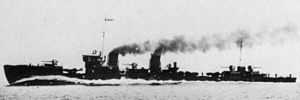Japanese destroyer Nokaze
 Japanese destroyer Nokaze | |
| Career | |
|---|---|
| Name: | Nokaze |
| Ordered: | 1918 fiscal year |
| Builder: | Maizuru Naval Arsenal |
| Laid down: | April 16, 1921 |
| Launched: | October 1, 1921 |
| Commissioned: | March 31, 1922 |
| Struck: | April 10, 1945 |
| Fate: | Sunk in action, February 20, 1945 |
| General characteristics | |
| Class & type: | improved Minekaze-class destroyer |
| Displacement: |
1,215 long tons (1,234 t) normal, 1,650 long tons (1,680 t) full load |
| Length: |
97.5 m (320 ft) pp, 102.6 m (337 ft) overall |
| Beam: | 8.9 m (29 ft) |
| Draught: | 2.9 m (9.5 ft) |
| Propulsion: | 2-shaft Mitsubishi-Parsons geared turbines, 4 boilers 38,500 ihp (28,700 kW) |
| Speed: | 39 knots (72 km/h) |
| Range: |
3600 nm @ 14 knots (6,700 km at 26 km/h) |
| Complement: | 148 |
| Armament: |
4 × Type 3 120 mm 45 caliber naval gun 6 × 21 in (533 mm) torpedo tubes 2 × 7.7 mm machine guns 16x naval mines |
| Service record | |
|---|---|
| Operations: |
Second Sino-Japanese War Pacific War |
Nokaze (野風 "Field Wind")[1] was the lead ship of the Nokaze sub-class, an improvement to the Minekaze-class 1st class destroyers built for the Imperial Japanese Navy following World War I. Advanced for their time, these ships served as first-line destroyers through the 1930s, but were considered obsolescent by the start of the Pacific War.
History
Construction of the large-sized Minekaze-class destroyers was authorized as part of the Imperial Japanese Navy's 8-4 Fleet Program from fiscal 1917 with nine vessels, and fiscal 1918 with an additional six vessels. However, the final three vessels in the fiscal 1918 were built to a different design and have a different enough silhouette that many authors consider them to be a separate class.[2] Nokaze, built at the Maizuru Naval Arsenal was laid down on April 16, 1921, launched on October 1, 1921 and commissioned on March 31, 1922.[3]
On completion, Nokaze was teamed with sister ships Namikaze, Numakaze, and flagship Kamikaze at Yokosuka Naval District to form Destroyer Division 1. In 1938-1939, this Division was assigned to patrols of the northern and central China coastlines in support of Japanese combat operations in the Second Sino-Japanese War
World War II history
At the time of the attack on Pearl Harbor, Nokaze was based at the Ōminato Guard District in northern Japan, and was assigned to patrols of the Hokkaidō and Chishima Islands coastlines.
During the Battle of Midway in May 1942, Nokaze was assigned to the reserve force for the Aleutian Islands Operation, which did not leave Japanese waters. Afterwards, it returned to patrol and escort duties based out of Ōminato through July 1943, when it was assigned temporarily to the IJN 5th Fleet for the mission to evacuate surviving Japanese forces from "Operation Cottage" (the evacuation of Kiska. Nokaze continued to be based at Ōminato for patrol and escort in northern waters until January 1945.
In January 1945, Nokaze was reassigned to the Combined Fleet, departing from Moji on January 26 with Convoy HI-91 bound for Singapore. However, Nokaze was ordered to Mako, where it was to join the destroyer screen for the battleships Ise, and Hyūga during Operation Kita. However, on February 15, there was a change of plans, and Nokaze was ordered to proceed instead to Singapore on its own.
On February 20, 1945, Nokaze was torpedoed and sunk by the submarine USS Pargo (SS-264) north of Nha Trang, French Indochina in the South China Sea at position 12°48′N 109°38′E / 12.800°N 109.633°ECoordinates: 12°48′N 109°38′E / 12.800°N 109.633°E. The ship exploded and sank, with 209 killed. Kamikaze rescued 21 survivors, including its captain, Lieutenant Commander Tarō Ebihara.[4] Nokaze was the last of 39 Japanese destroyers to fall victim to United States Navy submarines during the war.
On April 10, 1945 Nokaze was removed from navy list.[5]
References
- Brown, David (1990). Warship Losses of World War Two. Naval Institute Press. ISBN 1-55750-914-X.
- Howarth, Stephen (1983). The Fighting Ships of the Rising Sun: The Drama of the Imperial Japanese Navy, 1895–1945. Atheneum. ISBN 0-689-11402-8.
- Jentsura, Hansgeorg (1976). Warships of the Imperial Japanese Navy, 1869–1945. US Naval Institute Press. ISBN 0-87021-893-X.
- Nelson, Andrew N. (1967). Japanese–English Character Dictionary. Tuttle. ISBN 0-8048-0408-7.
- Watts, Anthony J (1967). Japanese Warships of World War II. Doubleday. ASIN B000KEV3J8.
- Whitley, M J (2000). Destroyers of World War Two: An International Encyclopedia. London: Arms and Armour Press. ISBN 1-85409-521-8.
External links
- Nishidah, Hiroshi (2002). "Minekaze class 1st class destroyers". Materials of the Imperial Japanese Navy.
- Jones, Daniel H. (2003). "IJN Minekaze, Kamikaze and Mutsuki class Destroyers". Ship Modeler's Mailing List (SMML).
- Nevitt, Allyn D. (1997). "IJN Nokaze: Tabular Record of Movement". Long Lancers. Combinedfleet.com. Retrieved 2008-06-11.
Notes
- ↑ Nelson. Japanese-English Character Dictionary. pages 296, 960
- ↑ Jones, Daniel H. (2003). "IJN Minekaze, Kamikaze and Mutsuki class Destroyers". Ship Modeler's Mailing List (SMML).
- ↑ Nishidah, Hiroshi (2002). "Minekaze class 1st class destroyers". Materials of the Imperial Japanese Navy.
- ↑ Nevitt, Allyn D. (1997). "IJN Nokaze: Tabular Record of Movement". Long Lancers. Combinedfleet.com.
- ↑ Nishidah, Hiroshi (2002). "Minekaze class 1st class destroyers". Materials of the Imperial Japanese Navy.
| |||||||||||